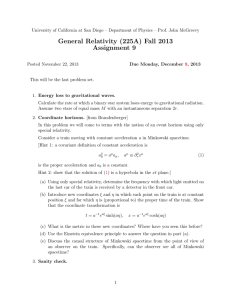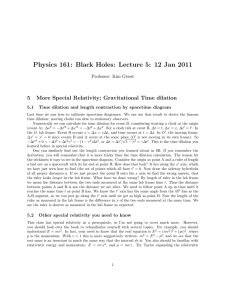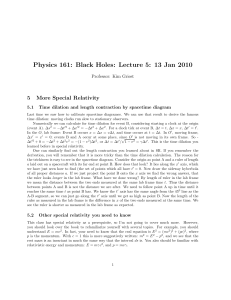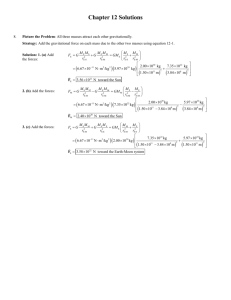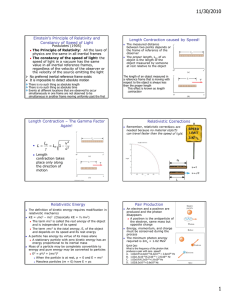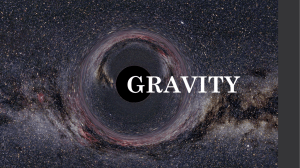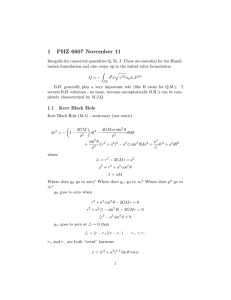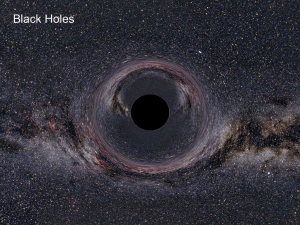General Relativity
advertisement
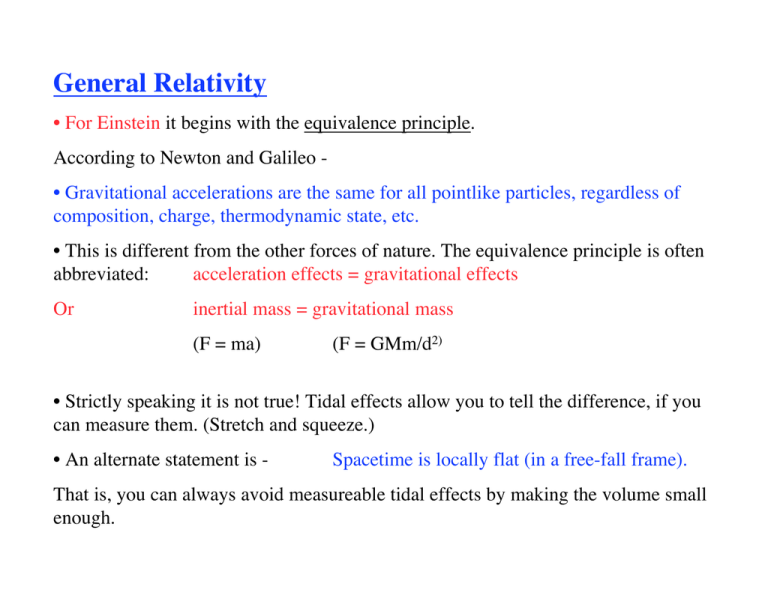
General Relativity • For Einstein it begins with the equivalence principle. According to Newton and Galileo • Gravitational accelerations are the same for all pointlike particles, regardless of composition, charge, thermodynamic state, etc. • This is different from the other forces of nature. The equivalence principle is often abbreviated: acceleration effects = gravitational effects Or inertial mass = gravitational mass (F = ma) (F = GMm/d2) • Strictly speaking it is not true! Tidal effects allow you to tell the difference, if you can measure them. (Stretch and squeeze.) • An alternate statement is - Spacetime is locally flat (in a free-fall frame). That is, you can always avoid measureable tidal effects by making the volume small enough. Space-time curvature The equivalence principle guided Einstein to the insight that gravity is the effect of curved spacetime. (Which is quite a leap!) And ultimately… Matter curves space, curved spacetime moves matter. (J. A. Wheeler). What is curved spacetime? No physical material is curved, so you can’t see it directly. How can you tell it’s curved? …geometry and measurement…. A Tale of Two Circles… Draw a circle of circumference C1 around a compact mass. Define the radius of the circle to be r1 = C1/2π. Now move inward drawing circles until you get one of circumference C2 = C1/2. Euclidean geometry would lead us to believe that the radius of the second circle is, r2 = C2/2π = C1/4π = r1/2. Now measure the distance between the 2 circles. If you find that Δr = r1 - r2 ≠ r1/2, then the space is curved. If Δr >> r1/2, then you are in big trouble! How the result above is possible. To check this geometric result another way, measure the angles around the inside of a triangle. NP Equator If the sum is not 180°, then the space is curved. Some other applications and corollaries - Radial lengths are “longer.” The actual distance between shells is longer than predicted in ‘far-away’ coordinates. Embedding diagrams help to understand this. Δr Δs -Gravitational time dilation: clocks tick slower in a gravity well. E.g., Object (2GM/c2r) at surface Δτ/(Δt = 1s) Earth 1.4 x 10-9 ≈1 WD 2.5 x 10-4 0.99987 NS 0.42 0.76 GPS signals must be corrected for this effect. This effect also contributes to cosmological redshift. - Gravitational redshift: dilation. ν ~ 1/P ~ 1/Δt, so essentially the same as the time - The existence of horizons: ultimately the escape velocity from a deep gravitational potential (strongly curved spacetime), exceeds the speed of light. A “horizon” is formed at this radius: RS = (2GM/c2). The horizon separates the interior from our universe. There are also cosmological horizons. Classical Dark Stars John Michell, rector of Thornhill, Yorkshire, 1783. Pierre Simon Laplace, 1796. The idea was based on the corpuscular theory of light, and the escape velocity. To reach ‘infinity’ (or go far away) a launched particle must have E ≥ 0. In terms of energy per unit mass, E/m = v2/2 - GM*/R ≥ 0, and so, the escape velocity is v = [2GM*/R]1/2. This relationship is not consistent with relativity, since for large M*, or small R, we have v > c. Light cannot escape, a dark star. When v = c, we can use the escape velocity formula to get RS = (2GM/c2), the maximum radius of dark stars. The idea of classical dark stars didn’t last, but the Schwarzschild radius did. Schwarzschild Geometry and Black Holes K. Schwarzschild discovered the global coordinate system (and metric) for a universe with one dominant point mass. The new spacetime interval is - 2GM 2 2 Δr 2 Δs = −1 − 2 c Δt + . 2GM c r 1 − 2 c r 2 For two spherical shells around the point mass this tells us that, € Δr Δs = Δrshell = , 1/2 2GM 1 − 2 c r Where Δrshell is the shell separation and Δr is the ‘faraway’ Δr, or that based on € circumference/2π. The spacetime interval also yields the gravitational redshift, Δτ = −Δs = Δt shell 2GM 1 / 2 = 1 − 2 Δt, c r where Δt is the ‘faraway’ time. € Some other consequences of the warped spacetime around BHs - Bent light rays. One’s field of view steadily contracts while falling towards a BH, it doesn’t just turn off at RS. R=0 r = 2Rs r = 3Rs Explanation: In the center of a swirling whirlpool of hot gas is likely a beast that has never been seen directly: a black hole. Studies of the bright light emitted by the swirling gas frequently indicate not only that a black hole is present, but also likely attributes. The gas surrounding GRO J1655-40, for example, has been found to display an unusual flickering at a rate of 450 times a second. Given a previous mass estimate for the central object of seven times the mass of our Sun, the rate of the fast flickering can be explained by a black hole that is rotating very rapidly. What physical mechanisms actually cause the flickering -- and a slower quasi-periodic oscillation (QPO) -- in accretion disks surrounding black holes and neutron stars remains a topic of much research. Drawing Credit: A. Hobart, CXC - BHs have 2 other measureable properties besides mass: charge and angular momentum. Other than that BHs have no hair! Black Hole Thermodynamics 1. The BH area theorem. Hawking proved that the surface area of a classical black hole cannot decrease in any physical process. E.g., if 2 BHs collide and coalesce, then the final area will be greater than or equal to the sum of their original surface areas: Atotal ≥ A1 + A2. 2. BHs are not completely black. Hawking found that BHs can radiate via Q.M. particle creation and tunneling. Q.M. allows spontaneous creation of particle-anti-particle pairs from the vacuum for a short duration. In the presence of a strong external field, the particle and anti-particle can tunnel away from each other with significant probability. Hawking showed that the emission is thermal, and characterized by a temperature of hc 3 −7 M sun T= ≈ 10 K. M 8πkGM This equation represents a (second) beautiful confluence of quantum, € thermodynamic and gravitational effects. The luminosity of the radiating BH is, L ~ R2T4 ~ M2 x M-4 ~ M-2. Specifically, L ≈ 1013 (1012kg/M)2 W. Rotating BHs - There exist complete mathematical solutions for both uncharged (Kerr) and charged (Kerr-Newman) BHs. - These solutions are more complex, and involve some new features. - Multiple horizons and infinite redshift surfaces, and these are no longer identical. - An ergosphere - within the infinite redshift surface, and outside the first singularity. It’s possible to escape from the ergosphere, but not possible to sit still. - There is a maximum amount of angular momentum (and charge) a hole of mass M can hold. - The Kerr solution has a disk singularity in its center, maybe … Alternate interpretation: joins to ‘another’ asymptotically flat spacetime. One might fall in along the rotation axis, go through r-, the inner event horizon, and maybe (if ‘geodesic completeness’ holds) emerge out a white hole in another universe! See transparencies.
